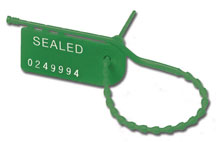



Find all of your laboratory and workplace safety supplies at Safety Emporium!
 Embolism |
 Glossary Index |
 Emphysema |
| MSDS Topics |
Free Sites | FAQ's | Regulations | Glossary | Software | Suppliers |
| Books | Forum | Poll | Fun stuff | Quiz | Store | |
| Understand your MSDS with the MS-Demystifier | Search ALL our MSDS info | |||||

Secure controlled substances, fire extinguishers, and other vital items with tamper and security seals from Safety Emporium.
An emetic is an agent that causes emesis (vomiting, upchucking, regurgitation, "losing one's cookies").
Vomiting is a natural body defense mechanism. Under certain conditions, your body perceives that an illness or injury may have been caused by ingestion of spoiled food or other toxin and empties the stomach contents as a preventative measure.
In the context of this Safety Data Sheet resource one is usually concerned about accidental ingestion of a poison. Obviously, stomach flu and other gastrointestinal illnesses are a much more common cause of vomiting and such conditions are beyond the scope of our discussion. See Additional Reading below for more on care and treatment of illness-related nausea and vomiting.
These terms usually appear on a Safety Data Sheet in Section 11 (toxicological information) as a symptom of exposure or in Section 4 (first-aid measures) in discussing appropriate and inappropriate first aid treatment.
Vomiting is a fairly common symptom of chemical exposure, usually in cases of acute (short-term) exposure. If someone is vomiting as a result of a chemical exposure, they should immediately seek professional medical assistance.
Syrup of ipecac was a first aid medicine that was used to induce vomiting when a poison was consumed (i.e. it was used as an antidote). It had long been recommended as an important part of first aid kits where children are present, however emerging evidence suggests that emergency room administration of activated charcoal is probably a better treatment choice for most poisoning cases. In fact, the American Academy of Pediatrics now recommends against the use of ipecac syrup in the home.
Why the warning? Because certain materials can cause additional serious damage and chemical burns to the esophagus and throat on the way back up. Petroleum products, sharp objects, acids, bases (lye, alkali) and other corrosive materials are examples of such materials. Likewise, vomiting may delay other treatments such as the administration of activated charcoal or prove dangerous if a victim has a seizure. Call the American Association of Poison Control Centers poisoning emergency number (800) 222-1222 (or dial 911), summon an ambulance, and/or take the victim to the nearest emergency room before inducing vomiting.

Safety Emporium carries bloodborne pathogen centers and related compliance materials.
NEVER attempt to induce vomiting in an unconscious person. The victim could aspirate (choke), leading to even more severe injury or death.
See also: activated charcoal, antidote, gastric, ingestion, poison.
Additional definitions from Google and OneLook.
Entry last updated: Sunday, July 24, 2022. This page is copyright 2000-2025 by ILPI. Unauthorized duplication or posting on other web sites is expressly prohibited. Send suggestions, comments, and new entry desires (include the URL if applicable) to us by email.
Disclaimer: The information contained herein is believed to be true and accurate, however ILPI makes no guarantees concerning the veracity of any statement. Use of any information on this page is at the reader's own risk. ILPI strongly encourages the reader to consult the appropriate local, state and federal agencies concerning the matters discussed herein.